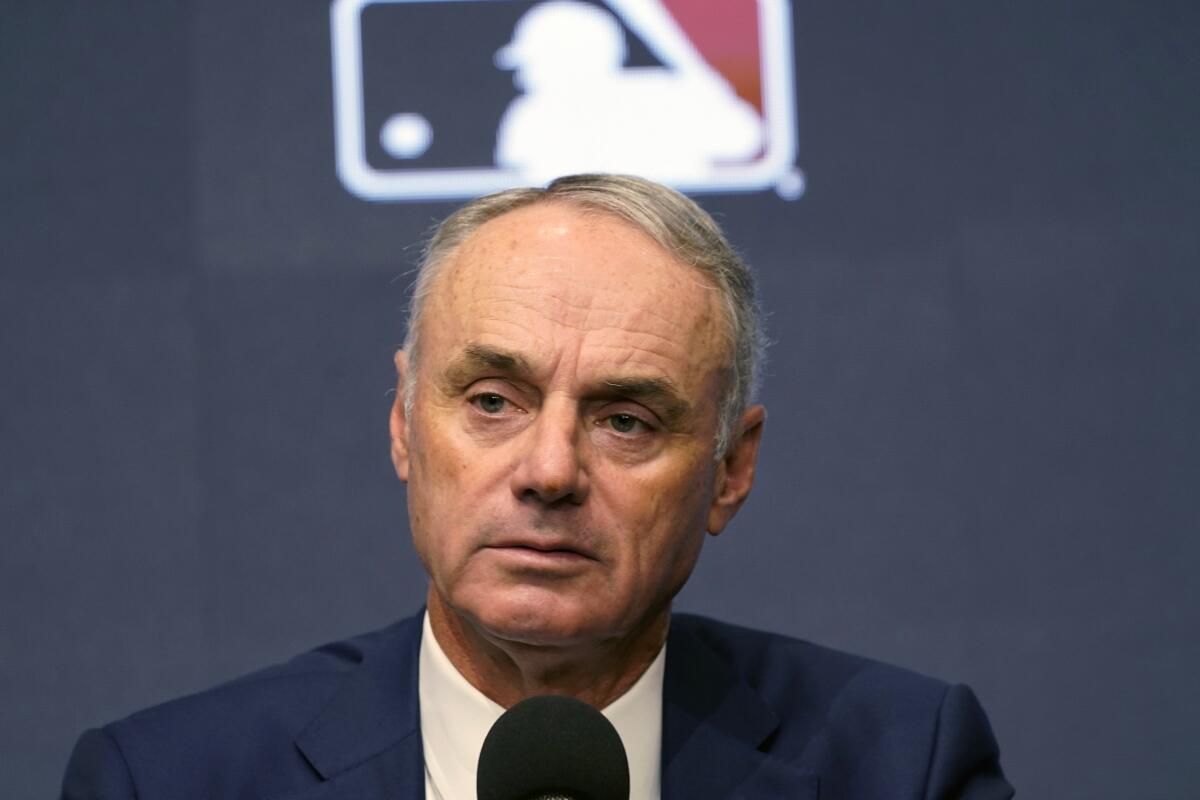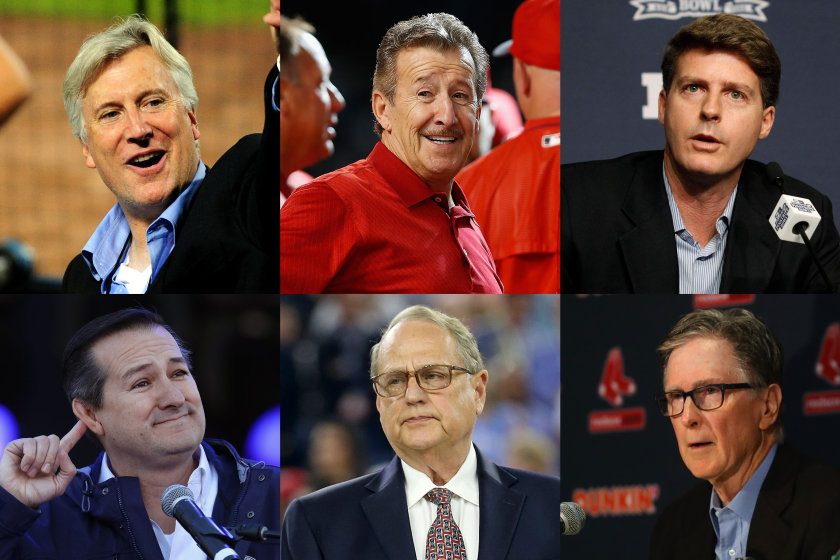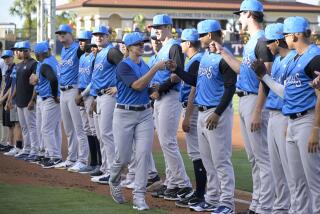MLB cancels first two series of 2022 season after no deal is reached to end lockout

- Share via
JUPITER, Fla. — Major League Baseball has canceled opening day, with Commissioner Rob Manfred announcing Tuesday the sport will lose regular-season games over a labor dispute for the first time in 27 years after acrimonious lockout talks collapsed in the hours before management’s deadline.
Manfred said he is canceling the first two series of the season that was set to begin March 31, dropping the schedule from 162 games to likely 156 games at most. Manfred said the league and union have not made plans for future negotiations.
“My deepest hope is we get an agreement quickly,” Manfred said. “I’m really disappointed we didn’t make an agreement.”
After the sides made progress during 13 negotiating sessions over 16 1/2 hours Monday, the league sent the players’ association a “best and final offer” Tuesday on the ninth straight day of negotiations.
Players rejected that offer, setting the stage for MLB to follow through on its threat to cancel opening day.
“Rob Manfred and MLB’s owners have canceled the start of the season,“ the union said in a statement. “Players and fans around the world who love baseball are disgusted, but sadly not surprised.
“Against the backdrop of growing revenues and record profits, we are seeking nothing more than a fair agreement. What Rob Manfred characterized as a ‘defensive lockout’ is, in fact, the culmination of a decades-long attempt by owners to break our player fraternity. As in the past, this effort will fail.”
At 5:10 p.m., Manfred issued a statement that many fans had been dreading: Nothing to look forward to on opening day, normally a spring standard of renewal for fans throughout the nation and some in Canada, too.
The ninth work stoppage in baseball history will be the fourth that causes regular season games to be canceled, leaving Fenway Park and Dodger Stadium as quiet in next month as Joker Marchant Stadium and Camelback Park have been during the third straight disrupted spring training.
“The concerns of our fans are at the very top of our consideration list,” Manfred said.
The lockout, in its 90th day, will plunge a sport staggered by the coronavirus pandemic and afflicted by numerous on-field issues into a self-inflicted hiatus over the inability of players and owners to divide a $10 billion industry. By losing regular-season games, scrutiny will fall even more intensely on Manfred, the commissioner since January 2015, and Tony Clark, the former All-Star first baseman who became union leader when Michael Weiner died in November 2013.
“Manfred gotta go,” tweeted Chicago Cubs pitcher Marcus Stroman.
Past stoppages were based on issues such as a salary cap, free-agent compensation and pensions. This one is pretty much solely over money.
This fight was years in the making, with players angered that payrolls decreased by 4% from 2015 through last year, many teams jettisoned a portion of high-priced veteran journeymen in favor of lower-priced youth, and some clubs gave up on competing in the short term to better position themselves for future years.
A team-by-team look at the billionaire MLB team owners who are behind the lockout that could delay the start of the 2022 season.
The sport will be upended by its second shortened season in three years. The 2020 schedule was cut from 162 games to 60 because of the pandemic, a decision players filed a grievance over and still are litigating. The disruption will create another issue if 15 days of the season are wiped out: stars such as Shohei Ohtani, Pete Alonso, Jake Cronenworth and Jonathan India would be delayed an extra year from free agency.
Players would lose $20.5 million in salary for each day of the season that is canceled, according to a study by The Associated Press, and the 30 teams would lose large sums that are harder to pin down. Members of the union’s executive subcommittee stand to lose the most, with Max Scherzer forfeited $232,975 for each regular-season day lost, and Gerrit Cole $193,548.
Scherzer and free-agent reliever Andrew Miller were present for talks. Both stopped to sign autographs for fans as they left Roger Dean Stadium, the vacant spring training home of the St. Louis Cardinals and Miami Marlins where negotiations have been held since the start of last week.
The first 86 games of the 1973 season were canceled by a strike over pension negotiations, the 1981 season was fractured by a 50-day midseason strike over free agency compensation rules that canceled 713 games, and a strike that started in August 1994 over management’s attempt to gain a salary cap canceled the final 669 games and led to a three-week delay of the 1995 season, when schedules were cut from 162 games to 144.
Players and owners entered deadline day far apart on many key issues and unresolved on others. The most contentious proposals involve luxury tax thresholds and rates, the size of a new bonus pool for pre-arbitration players, minimum salaries, salary arbitration eligibility and the union’s desire to change the club revenue-sharing formula.
While the differences had narrowed in recent days, the sides remained apart, with how far apart depending on the point of view.
MLB proposed raising the luxury tax threshold from $210 million to $220 million in each of the next three seasons, $224 million in 2025 and $230 in 2026. Players asked for $238 million this year, $244 million in 2023, $250 million in 2024, $256 million in 2025 and $263 in 2026.
MLB proposed $25 million annually for a new bonus pool for pre-arbitration players, and the union dropped from $115 million to $85 million for this year, with $5 million yearly increases.
MLB proposed raising the minimum salary from $570,500 to $675,000 this year, with increases of $10,000 annually, and the union asked for $725,000 this year, $745,000 in 2023, $765,000 in 2024 and increases for 2025 and 2026 based on the Consumer Price Index for Urban Wage Earners.
More to Read
Go beyond the scoreboard
Get the latest on L.A.'s teams in the daily Sports Report newsletter.
You may occasionally receive promotional content from the Los Angeles Times.











